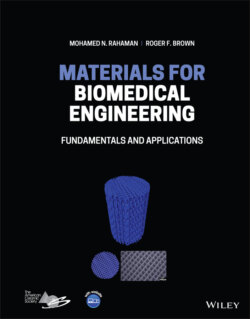Читать книгу Materials for Biomedical Engineering - Mohamed N. Rahaman - Страница 88
3.3.2 Crystal Structure of Ceramics
ОглавлениеThe simplest ionic‐bonded ceramics are compounds composed of ions of a metal and a non‐metal that have discrete charges of opposite sign as in NaCl, for example (Chapter 2). Electrostatic bonding between the cations and anions provide the dominant contribution to the bonding energy. The bonding is non‐directional and the ions tend to pack as densely as possible. One type of ion surrounds itself with as many ions of the opposite sign as possible, with the constraint that ions of the same sign must not touch, maximizing the electrostatic potential energy of attraction. Thus, the majority of ceramics with a high degree of ionic bonding have crystal structures based on FCC or CPH packing.
Although it is not used as a biomaterial, NaCl is often taken as an example of a ceramic material that shows a high degree of ionic bonding. In NaCl crystals, each type of ion is surrounded, that is, coordinated, by six ions of the opposite sign. (Figure 3.8). The unit cell is cubic and the structure can be considered as composed of two interpenetrating FCC lattices of the cations (Na+) and anions (Cl−).
Figure 3.8 Arrangement of sodium ions (Na+) and chlorine ions (Cl−) in a sodium chloride unit cell.
Aluminum oxide (Al2O3 ), often referred to as alumina or α‐alumina, is used as articulating bearings in hip implants (Chapter 1). Although alumina has aclose‐packed hexagonal (CPH) structure, the arrangement of the ions has to take into account the dissimilar cation to anion ratio (2 : 3) and the geometrical restriction that each type of ions must not touch. The structure can be viewed as composed of layers of O2− ions stacked in a direction perpendicular to the basal plane between which two‐thirds of the interstitial atomic sites are occupied by Al3+ ions and one‐third is empty.
Zirconium oxide (ZrO2 ), often referred to as zirconia, exists in three different crystalline forms called polymorphs (Chapter 7). The cubic form transforms to tetragonal below ~2370 °C that, in turn, transforms to a monoclinic structure below ~1240 °C. In addition to the change in crystal structure, the transformation to the monoclinic structure is accompanied by a volume expansion of ~4.7% that cannot be easily accommodated in the solid. When zirconia is cooled from its fabrication temperature, typically well above the tetragonal to monoclinic transition temperature, this volume change leads the creation of microcracks and, thus, to a weak material. Consequently, zirconia is not useful in engineering or biomedical applications. On the other hand, upon the addition of a few percent of yttrium oxide (yttria), Y2O3 , or magnesium oxide (magnesia), MgO, for example, the cubic or tetragonal phase can be retained as a metastable phase on cooling to room temperature. When fabricated under well‐controlled and reproducible conditions, yttria‐stabilized zirconia (YSZ) with a tetragonal structure (~3 mol% Y2O3), is among the ceramics with the best mechanical properties. YSZ is shaped and used as dental restorations such as crowns and bridges and, in particulate form, it is incorporated into alumina in the production of zirconia‐toughened alumina (ZTA) bearings for hip implants. These bearings have better resistance to cracking than alumina due to transformation of the YSZ particles to the monoclinic phase in the vicinity of an approaching crack (Chapter 7). As this transformation uses up some of the energy that would be otherwise available for crack propagation, growth of the crack is blunted.
Many of the strongest, hardest, and most refractory ceramics have structures with a high degree of covalent bonding. Several of these ceramics, such as carbon in the form of diamond, silicon carbide (SiC) and silicon nitride (Si3N4 ), for example, show a tetrahedral arrangement of the bonds due to sp3 hybridization of the valence electron orbitals in atoms such as carbon and silicon (Chapter 2). As there are a fixed number of directional bonds in covalent bonding, the position and number of neighboring atoms in the structure are also fixed. Diamond is often considered prototypical of solids that show strong covalent bonds. It consists of a cubic unit cell in which the atoms are located at the corners of a tetrahedron due to sp3 hybridization of the valence electron orbitals of the carbon atoms (Section 3.3.4). Silicon nitride is used in spinal fusion implants and it is being developed for use as femoral head bearings in hip implants. It has a hexagonal crystal structure in which each silicon atom is bonded to four nitrogen atoms due to sp3 hybridization of the silicon atom. These SiN4 tetrahedra are joined together by three nitrogen atoms in a trigonal planar arrangement due to sp2 hybridization of the electron orbitals in nitrogen.
In silicon dioxide (SiO2 ) commonly called silica, the four hybridized sp3 orbitals in silicon leads to a strong preference for the formation of SiO4 tetrahedra, in which the oxygen atoms are located at the corners of the tetrahedron in both the crystalline and amorphous states. Crystalline silica, for example, is composed of an ordered repeating pattern of three‐dimensional structures in which the oxygen atom at each corner of an SiO4 tetrahedron is shared with that of a neighboring tetrahedron. Crystalline silica occurs in three different crystalline forms (polymorphs) called cristobalite, tridymite, and quartz. Figure 3.9a illustrates the arrangement of the SiO4 tetrahedra in cristobalite.
Figure 3.9 Illustration of (a) ordered arrangement of SiO4 tetrahedra in crystalline silica (cristobalite) and (b) non‐ordered arrangement in amorphous silica glass.
